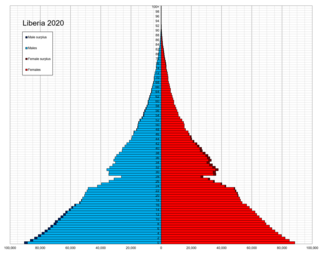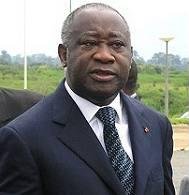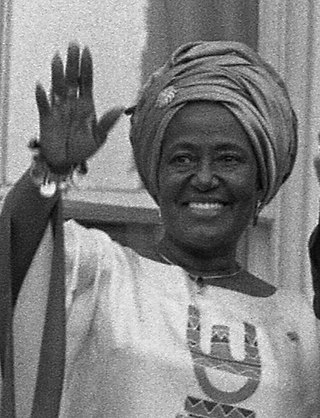
As of 2006, Liberia has the highest population growth rate in the world. 43.5% of Liberians were below the age of 15 in 2010. With recent civil wars being fought along ethnic lines, Liberia is a multiethnic and multicultural country.

The flag of Liberia or the Liberian flag, sometimes called the Lone Star, bears a close resemblance to the flag of the United States, representing Liberia's founding by former black slaves from the United States and the Caribbean. They are both part of the stars and stripes flag family.

Monrovia is the capital city of the West African country of Liberia. Founded in 1822, it is located on Cape Mesurado on the Atlantic coast and as of the 2008 census had 1,010,970 residents, home to 29% of Liberia’s total population. As the nation's primate city, Monrovia is the country's economic, financial and cultural center; its economy is primarily centered on its harbor and its role as the seat of Liberian government.

Grand Cape Mount is a county in the northwestern portion of the West African nation of Liberia. One of 15 counties that constitute the first-level of administrative division in the nation, it has five districts. Robertsport serves as the capital with the area of the county measuring 5,162 square kilometres (1,993 sq mi). As of the 2008 Census, it had a population of 129,817, making it the eighth most populous county in Liberia. The county is bordered by Gbarpolu County to the northeast and Bomi County to the southeast. The northern part of Grand Cape Mount borders the nation of Sierra Leone, while to the west lies the Atlantic Ocean.

The Kru, Kroo, Krou or Kuru are a West African ethnic group who are indigenous to western Ivory Coast and eastern Liberia. They migrated and settled along various points of the West African coast, notably Freetown, Sierra Leone, but also the Ivorian and Nigerian coasts. The Kru people are a large ethnic group that is made up of several sub-ethnic groups in Liberia and Ivory Coast. These tribes include Bété, Bassa, Krumen, Guéré, Grebo, Klao, Dida, Krahn people and, Jabo people. The Kru people were more valuable as traders and sailors on slave ships than as slave labor. To ensure their status as “freemen,” they initiated the practice of tattooing their foreheads and the bridge of their nose with indigo dye to distinguish them from slave labor.

Daniel Edward Howard was the 16th president of Liberia, serving from 1912 to 1920.
The Bassa language is a Kru language spoken by about 600,000 Bassa people in Liberia, Ivory Coast, and Sierra Leone.

Dr. George Toe Washington was a Liberian three-star general and political figure. He served as Army Chief of Staff under President William V.S. Tubman. In Liberia's 1997 presidential election, he ran for the PDPL, receiving 0.56% of the popular vote. After the election, allegations were made of corruption, including that the location where Washington had cast a vote for himself reported zero votes for him.
The Liberian National County Meet is the top knockout county tournament of the Liberian football inaugurated in 1956.
Lafayette K. Morgan, former economic advisor of the Republic of Liberia, was an accomplished accountant and financial expert.

Liberia is divided into fifteen first-level administrative divisions called counties, which, in turn, are subdivided into a total of 90 second-level administrative divisions called districts and further subdivided into third-level administrative divisions called clans.

Antoinette Louise Padmore Tubman was the wife of the Liberian politician William S. Tubman and was First Lady of Liberia from 1948 until 1971.
Nathaniel Varney Massaquoi (1905–1962) was a Liberian educator and politician, from the Vai community.

Fatima Massaquoi-Fahnbulleh was a Liberian writer and academic. After completing her education in the United States, she returned to Liberia in 1946, making significant contributions to the cultural and social life of the country.
Zolu Duma, also known as King Peter, was a Bassa-Dei ruler of the land situated on Bushrod Island. Bushrod Island is in Montserrado County, Liberia. Today, King Peter's Town where his Palace was stationed is in the area of Logan Town on Bushrod Island. Zolu Duma was raised by the Wuling, of the Bassa people who had gained importance as a merchant trading with the Europeans, including slave trade.

Lewis Penick Clinton was a Prince of the Bassa people in West Africa (Liberia) and later an African American missionary and lecturer.
Edith Mai Padmore, nee Wiles was a Liberian politician. She became Liberia's first female cabinet minister when she was appointed Minister of Health and Welfare in 1972.

Victoria Anna David Tolbert was the First Lady of Liberia from 1971 to 1980.

Didwho Welleh Twe was a Liberian politician. He became a representative in the Liberian legislature and a presidential candidate in the 1951 Liberian general election. A review of his life shows that he was an advocate of Liberian native rights and the first Liberian of full tribal background to officially and openly seek the Liberian presidency. Since 1847, the country was ruled by descendants of American former Black slaves known as Americo-Liberians until 1980. The descendants constitute less than ten percent of the population.




















